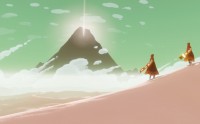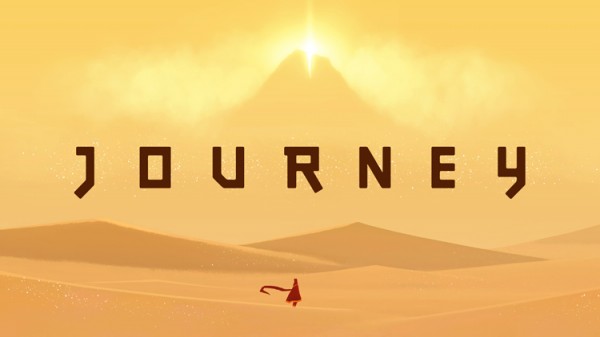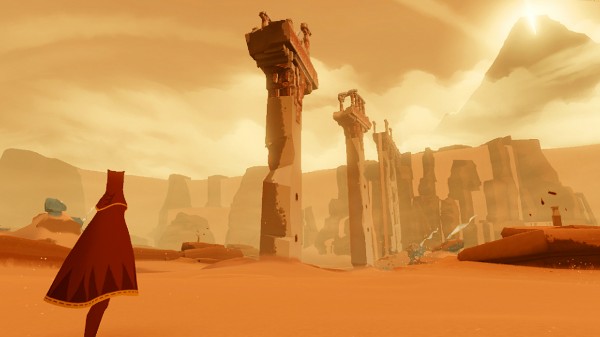Here in England, GameCity, a games festival, has just wrapped up. Unfortunately, I wasn’t able to attend a lot of the events there, but one thing I made doubly sure I had time for was a live demonstration of Journey, the forthcoming game from ThatGameCompany.
ThatGameCompany have an already impressive pedigree. As the creators of Flow and one of my favourite PSN games to have come out, Flower, they have a lot of eyes on them as they gear up for the release of Journey, which has been in beta for a while now. Leading Producer, Robert Hunicke, who has previously worked on games like Boom Blox and MySims, took the stage and told everyone present that she wasn’t going to talk that much. She was simply going to play, and that people who were lucky enough to have been sat next to the various PlayStation consoles around the room are welcome to play with her. She said that they may run into each other and they may not, but not to look at her screen and just enjoy the journey. Those of us in the audience were free to look wherever we pleased.
And so, she began playing, as did the others around the room. I’m not going to talk at length about the actual journey, since that’s the whole point of the game and I don’t want to ruin it for anyone, but needless to say there are some incredible sights to see. From observing Hunicke’s demonstration and watching other players around the room, it’s clear that people are going to play this game differently from others. Hunicke wasn’t spending much time looking around, heading for the more obvious objectives in an effort to finish the demonstration in time. Other people were going even faster than her, and others were miles behind. Everyone was experiencing the journey differently, taking in the sights and checking out every little thing they could lay their eyes on, while others merely went where they thought they were supposed to go.
Eventually, Hunicke met another player. Glancing around the room, I couldn’t identify them as any of the others present, so I presumed this player must be part of the beta or someone with early access to the game. They seemed to delight in each other’s company, jumping around and calling to the other. Of course, in Journey, there is no obvious way to communicate with another player or arrange a meeting, you simply may or may not run into another player and if you do, you won’t identify them. You can merely make some call out to them which sounds like a musical note. It varies in pitch but you can’t pick which one you make, you simply press square and see which one comes out. This is the same action/sound you make when interacting with things, as I talk about a bit later on.
They helped one another and stuck together until the end of the demo, after which, Hunicke said that those of us not playing already could go ahead and line up, and that’s when I got my hands-on time with Journey.
As you start the game, it immediately becomes apparent that you are a small entity in a very large world. Off in the distance is the fabled mountain that is supposedly the destination of your journey. In more immediate view, however, is a small hill. I headed for it and as I reached the top, the title of the game appeared on the screen in front of the distant mountain. I went off down the hill, unable to do anything but walk. I walked past what appeared to be graves, but what they really are is anyone’s guess. That’s the point. Journey doesn’t feel the need to explicitly explain its world to you. It’s clear that there was more here once. Ruins can be seen in the distance and even visited, but you’re just an explorer with no idea as to what has happened here. Perhaps it becomes more apparent later on, but for now, I just soaked in the eerie, lonely atmosphere.
I kept travelling, gaining new abilities as I went. As far as I saw, these abilities always allowed you to get to the next area and to continue exploring. They were also context sensitive. For example, pressing X, the jump button, while near lots of circling cloth (scrolls?), you could fly for a short moment. This would allow me to jump over some large chasm or another. I wasn’t allowed to simply fly around the desert at will now. It was clear when the game wanted you to use these abilities, and what to use them for. Another was the ability to turn a flag or banner into a pathway that the player could travel along, and again, this was context sensitive, merely walking up to it triggered the ability. I also noticed that as I learned a new ability, the player characters clothing changed. The scarf that he/she/it wore got longer, the patterns at the base of the robe got more intricate.
The music played away, very subtle at times, other times peaking and becoming huge. Austin Wintory, the talent behind Flow’s music, has created another fantastic score for Journey.Eventually, as I travelled, I just happened to look up and spot what appeared to be a meteor flying from nearby the mountain and hitting the ground. It would have taken me off course, but I had to go and find the spot where it had crashed, and so I went. Some strange sand-diving creatures that appear to be made of cloth (not unlike the player) seemed to be heading for it too. When I got to the approximate landing place, the creatures were just hanging around, and a white collectible was waiting for me near what looked to me like the wreckage of a building. It’s all open to interpretation, and that’s what I love about Journey.
It’s hard to say what is likeable about Journey. Make no mistake, it is likeable, but to those who haven’t played the game, it probably feels like it’s merely about walking in the desert. I guess it is, but it’s about what you see and about getting to the destination. There were short moments in the game in which I had to interact with some statues to trigger a cut-scene, but I wouldn’t exactly call them puzzles, considering all I had to do was light them up with the wordless call that I had seen Hunicke use to communicate with the stranger she happened upon earlier.

With Flower, there was a more obvious goal. To liven up the environment, to gather all the petals and then to send them all to the finish line where the level would become full of life once more. With Journey, the goal is more drawn out. While it’s mere speculation based on what I’ve played, it feels a little bit like, instead of Flower, which had separate, short levels, it’s all one big level, in which you can explore at will and also go to the checkpoints as they are, and the mountain is that finish line.
By the time I had to pass on my controller to the hungry crowd behind me, I hadn’t met another player, but I had enjoyed my time exploring Journey’s world, however short it was. I’m looking forward to getting back out there and continuing the journey.


